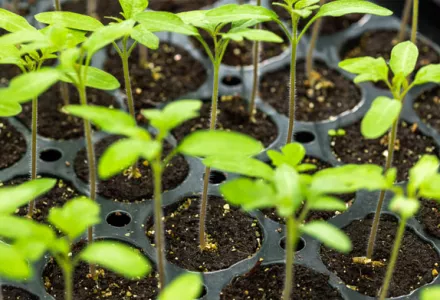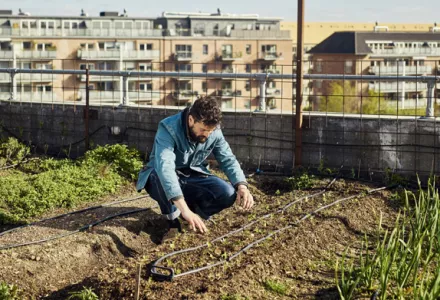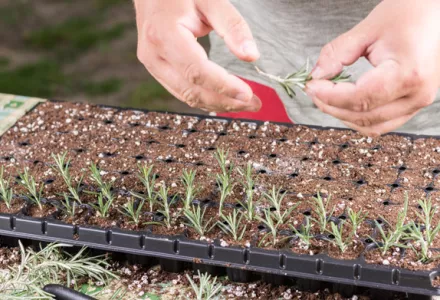Nothing could be simpler - take a pair of scissors, cut some tips off a plant, place the cut tips into the potting mix and away they go, right? Wrong. OK, then take a pair of scissors, cut some tips off a plant, place the tips in a propagator and away they go, right? Sorry, wrong again. While the steps are correct, there is much more to consider to ensure success with cuttings. Expensive equipment is not the answer, doing your homework is.
Plant cuttings are a reflection of their origin. Plant cuttings are a part of the original stock plant and they share the same balance of light, air, water, and nutrients as the stock plant. If the stock plant was deficient in Phosphorous, for example, then the cutting will also be deficient in Phosphorous. This problem is compounded by the fact that the cutting no longer has legs (roots) and therefore cannot get access to food or drink. The plant which grows from a cutting will show any problem (i.e. nutritional deficiency) rapidly and throughout its development.
Prepare the stock plant
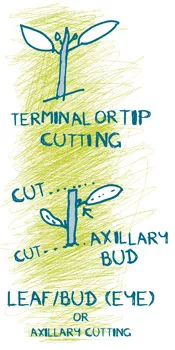
The stock plant needs to be growing actively but not forced to grow too fast as we want to force the cutting to form roots and minimize the risk of it having a vegetative growth surge. Ensure the stock plant is being fed on a regular basis but do not give it too many nutrients (especially Nitrogen), as this will cause an imbalance in carbohydrate storage, resulting in soft cuttings that have little energy for rooting. Overfeeding will reduce the number, size and quality of the root initials. The fertilizer ratios that could be used are as varied as the number of plant species the cuttings can come from, so we won’t make any recommendation here, other than to feed the stock plant according to how it is growing. If you are working only with terminal cuttings , they should be as tight as possible, so as to avoid too much internode stretch. Cut back on the amount of Nitrogen being fed to the stock plant if internode stretch becomes obvious.
You also want to avoid any other nutrient deficiencies - the plant should appear healthy with glossy green leaves and thick cuticles. Keep the light level up during growth periods, but reduce the amount of light the stock plants are exposed to by one third in the week before you take your cuttings. If you reduce the light level too much, you will induce internode stretch. Once you have taken the cuttings which can be as big a shock to the plant as loss of roots, transfer it into a reduced light environment. Make sure you water your stock plant the day before you take cuttings and it is best to take your cuttings during the first hours of light . It is also wise to make sure that the stock plant has been in a stable growth routine and has not dried out in the preceding two weeks. A stable, vigorous, healthy stock plant will yield cuttings of similar quality.
Prepare to take cuttings
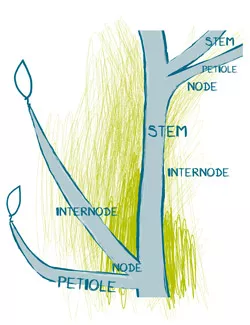
Now that we have ensured that the stock plant is as healthy as it can be, it must be time to get out the scissors......No! Taking a cutting requires care! Choosing the correct tip to keep is important, but equally it is important to know where to cut, how to cut, what to use to cut, and how to care for the cutting afterwards. Why? Because you want to make good use of every possible cutting, and so minimize the number of stock plants and the amount of space required for keeping up production. It also will result in even rooting between cuttings with a lower number of ‘blind’ cuttings ; blind cuttings don’t readily form into new plants.
There are four different types of cuttings to con- sider; hardwood (deciduous species), hardwood (narrow leaf evergreen species), semi-hardwood, and softwood (greenwood) cuttings. There are also many ways to cut and treat cuttings depend- ing on the type of cutting. These methods are based on the type of plant (woody to soft), production time (seasonal changes) and end-use. The softwood approach will be used to demonstrate the steps involved, as it is common to all types of wood, although it is confined to spring growth for woody plants.
Where to cut
The right location to take a cutting is a zone some- where in the middle of the stem which is not too hard and not too soft. There is a zone on every plant stem that goes from low carbohydrates and high Nitrogen to high carbohydrates and low Nitrogen; you want the middle of this zone. How do you tell where this is? Most growers know this from experience, but new or less experienced growers might want to do the ‘bend test’. You bend a tip still on the plant at a point where you want to take the cutting back on itself. There are three things that could happen: it bends (high Nitrogen and low carbohydrate), it snaps in half or nearly in half (low Nitrogen and high carbohydrates), or it partially breaks in one spot (just right). This spot is the cut zone. This is the section of the stem where roots will most readily form. Next we need to know where on the stem to cut.
How to cut
The internode is the section of the stem between leaf sets. Some plants form new roots from the node (where the leaves attach), some form them along the internode section. The key is to cut as close to the node as possible on those plants that form at the node and halfway for those that root along the internode. Now for the big news ... cut it straight, not angled ! Calluses form faster and seal off the stem quicker on a straight cut than on an angled cut, thereby reducing the incidence of dis- ease. However, cut flowers such as roses should be cut on an angle to encourage the stem to absorb as much water as possible and the wound to stay open to transfer the water. But when taking cuttings, take care to avoid crushing the tissue at the cut. Use a very sharp knife or bypass pruners.
It is difficult to avoid crushing the tissue at the cut, but the impact can be reduced by selecting the correct cutting tool. The cut must be clean and crisp. It really depends on the material being cut. Herbaceous material and very thin woody material are best cut with a specialist knife, called a propagation or budding/grafting knife. The next best option is bypass pruners. Scissors, anvil pruners, and fingers should be avoided as they crush the stem and don’t produce a clean cut.
Be kind to your cuttings
All cuttings need to go directly to an environment with 100% humidity after being cut. If the cuttings dry out, they will not do well. Keep them dark, cool and moist. If you are working in large areas, use wet cheesecloth or burlap to wrap the cuttings as you go along. Should we allow the cuts to dry out a little before sticking them in medium? No - while herbaceous cuttings are less likely to rot, they also root faster than woody plants because they contain less lignin in their stems. Don’t give them time to dry out. Process them soon as possible to keep the auxins flowing down the stem since they need to work at the bottom. A word of caution here - if you, the grower, use a rooting chamber that sprays a mist onto the cutting stems but does not include top humidity control, it might be advisable to cut the cutting stems at an angle to allow for water penetration, since these propagation units depend on this to regulate the supply of water to a cutting.
Rooting medium
The media for rooting should be similar to the medium that will be used for growing the cuttings in later: use an inorganic medium for inorganic systems, and an organic medium for organic systems. You must match the properties. Plants develop new roots with characteristics suited to the particular medium and the subsequent job they must do. If you are growing in potting mixes or in a soilless mix, it makes little sense to induce roots on a cutting by using a water-based rooting system. Otherwise, the plant will have to devote time and energy to converting those roots to roots that will work in the new environment, where water is scarcer than minerals. If you intend to grow your cuttings in clay pebbles, then root them in water, rock wool, or floral blocks. This will insure root compatibility from the start. Avoid sticking the cuttings in too deep - while tomatoes can handle being transplanted deep, most plants cannot. For plants that root at the node - bury the node, for plants that don’t root at the node - leave the node above the medium. Finally, make sure you water the cuttings when you’ve finished. This ensures a seal develops on the stem and settles the cutting into place.
Growing conditions
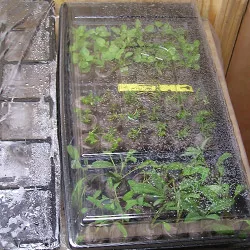
Now what’s the next step? Let’s see, we fed the stock plant, took the cuttings, transferred the cuttings into suitable medium... now we need get them under 100% humidity. This can be achieved with a dome or a mist system. Some plants are not particular and can withstand drier conditions (e.g. cacti or succulents), others will benefit from this approach. Humidity reduces the water use and supplies water to the growing plant. Humidity is essential to keep the leaf turgid, the systems functioning, and the processes processing. Keeping the lights at a lower intensity will enhance rooting while decreasing leaf function to survival levels. It will slow transpiration while the necessary components are used at the root sites to build a new root structure.
Keep the atmosphere around the cutting warm (not hot), keep the humidity relatively high (>90%), and keep the root zone temperature warm (at about 25o C). Maintain this humidity until you can see callus tissue or root initials , then you can allow the cuttings to grow at below 90% humidity but above 80% humidity in order to encourage root growth. When you can see roots in the surrounding medium, it is time to reduce to 80% humidity and stop spraying water on the leaves in order to limit risk of disease. When the roots reach the outside of the root cube or pot, transplant them.
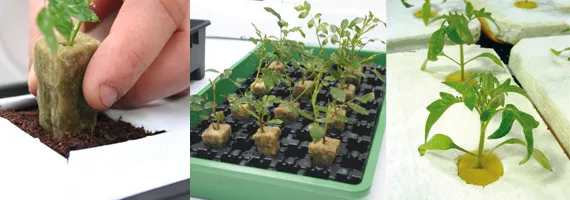
When to transplant cuttings
The timing here is important. If you wait until the roots have grown into a root ball, the roots will be old, ‘pot-tight’, and likely to grow on with less branching. Don’t wait until the roots have grown too much. Do not apply materials to help with root growth until the cuttings are transplanted. If you are rooting your cuttings into a medium, then use these materials as soon as you notice the roots (some root-aids can be supplied through the leaf earlier). A word of caution: never transplant freshly rooted cuttings into a container that is too large, use an intermediate size. For instance, do not transplant a 1 inch cube with a rooted cutting into a 20 liter container, use an intermediate size such as a 4 inch for root formation. The plant won’t suffer and there is less risk of it being over-watered.
A critical point to make at this juncture: roots re- quire 100% humidity to avoid damage. The longer the root tips are exposed to air, the greater the damage that is done. Minimize their exposure time to the air. Do not harvest hundreds of plugs in he morning then wait until the afternoon to plant them. Only harvest, or remove from the starter trays exposing the roots, enough material that you can deal with in 15 minutes. Once planted in the medium, ALWAYS water your transplants in, with or without feed, depending on the medium and ALWAYS adjusted to the bare minimum needed.
Transplanting Cuttings: Best Practice
A cutting that is being transplanted the first time should not be forced to swim in a huge pot that contains an ocean of media. It is not wise to place a 4-inch cutting directly into a 20 liter container, as it is not efficient use of space and it is difficult to keep the climate under control in such a large container. Transplant it into a smaller container first and allow it to gain root volume, then transfer it into a larger container. The same rules apply for roots, once the roots are loose and growing as far as the outside of the root ball in good numbers, move the plant up to a larger container. This will make it easier to keep water levels constant, avoid over-watering, ensure adequate nutrient availability, and make harvesting easier.
Transplant it into a smaller container first and allow it to gain root volume, then transfer it into a larger container. The same rules apply for roots, once the roots are loose and growing as far as the outside of the root ball in good numbers, move the plant up to a larger container. This will make it easier to keep water levels constant, avoid over-watering, ensure adequate nutrient availability, and make harvesting easier.
The timing and amount of fertilizer to apply will de- pend on the medium you are using. If you add fertilizer to a medium such as potting mixes or peat, then a large proportion of it will adhere to the particles either directly or through bind sites. If there is not enough plant material to use these nutrients, they will remain in the medium and can ultimately lead to high salt levels later on. So, feed new cuttings and plants lightly and increase the amount of fertilizer you give to your young plants in proportion to the rate of root growth.
Foliar feeds can be applied to leaf surfaces but in light amounts. Beware that Nitrogen and some other elements have a tendency to leach out of leaves under a mist system. Usually, a light amount of foliar feeding is recommended where roots form in less then five days. The root system is considered to be the best way to feed the plant and this holds true throughout the plant’s life. If a plant re- quires foliar applications there is usually a problem elsewhere in the plant that should be addressed.
Taking cuttings is straightforward when done correctly and when the grower is familiar with the plant species. Some plants don’t propagate well at all. Some take weeks to grow new roots, some start growing new roots while still on the stock plant. You need to know what is possible with the plant you have chosen so you to know what to expect. Re- member, cutting any living plant has consequences, for both the cutting and for the stock plant. Follow these steps carefully, take care of the stock plant and cuttings and you will succeed!
CANNA RHIZOTONIC is a popular product to apply to cuttings. Once root initials have formed, the product helps within the root zone.

